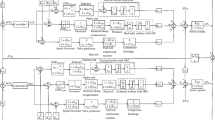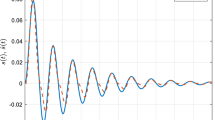Abstract
A generalized predictive control method based on neuro-fuzzy network (NFN-GPC) is presented for a 1000-MW ultra-supercritical (USC) power plant to improve control performance. First, to decrease the nonlinearity, local linear models are elaborately constructed for approximating the studied system by virtue of neuro-fuzzy network (NFN). Second, a compensation mechanism is delicately developed to further increase the accuracy of local models. Through gauss function and B-spline function, the memberships of local models which represent the weights of local regions are determined. Finally, based on the obtained models, a multi-variable generalized predictive controller is designed to realize the optimal control over the whole operating region combined with the membership of the current neuro-fuzzy network. This scheme closely connects engineering with artificial intelligence; compared with traditional generalized predictive control, the merit of proposed NFN-GPC is that it can capture the details over the whole operating range which can get more accurate and faster control effects. The simulation results show that the proposed neuro-fuzzy generalized predictive control method can achieve the satisfactory performance even in the case of strong coupling and nonlinearity. In conclusion, the proposed method is an effective long-term approach to control the USC power plant.









Similar content being viewed by others
References
Surywanshi GD, Pillai BBK, et al. 4-E analyses of chemical looping combustion based subcritical supercritical and ultra-supercritical coal-fired power plants. Energy Conv Manag. 2019;200:112050.
Beér JM. High efficiency electric power generation: the environmental role. Prog Energy Combust Sci. 2007;33(2):107–34.
Danilo HD, et al. Exergoenvironmental analysis of a ultra-supercritical coal-fired power plant. J Clean Prod. 2019;231(10):671–82.
Li Y, Ang KH, Chong GCY. Patents software and hardware for PID control: an overview and analysis of the current art. IEEE Control Syst Mag. 2006;26(1):42–54.
Silva RN, Shirley PO, Lemos JM, Goncalves AC. Adaptive regulation of super-heated steam temperature: a case study in an industrial boiler. Contr Eng Pract. 2000;8(8):1405–15.
Clarke DW, Mohtad C, Tuffs PS. Generalized predictive control-part I. Automatica. 1987;23(2):137–48.
Clarke DW, Mohtad C, Tuffs PS. Generalized predictive control-part 2. Automatica. 1987;23(2):149–60.
Hogg BW, El-Rabaie NM. Multivariable generalized predictive control of a boiler system. IEEE Trans Energy Convers. 1991;6(2):282–8.
Zhang H, Liu Y, Dai J, Wang Y. Command filter based adaptive fuzzy finite-time control for a class of uncertain nonlinear systems with hysteresis. IEEE Trans Fuzzy Syst. 2020;29(9):2553–64. https://doi.org/10.1109/TFUZZ.2020.3003499.
Peng H, Ozaki Y, Haggan-Ozaki V, Toyoda Y. A nonlinear exponential ARX model-based multivariable generalized predictive control strategy for thermal power plants. IEEE Trans Control Syst Technol. 2002;10(2):256–62.
Rossiter JA, Ding Y. Interpolation methods in model predictive control: an overview. Int J Control. 2010;83(2):297–312.
Zandi Z, Mazinan AH. Maximum power point tracking of the solar power plants in shadow mode through artificial neural network. Complex Intell Syst. 2019;5(3):315–30.
Zhang H, Liu Y, Wang Y. Observer-based finite-time adaptive fuzzy control for nontriangular nonlinear systems with full-state constraints. IEEE Trans Cybern. 2020;51(3):1110–20. https://doi.org/10.1109/TCYB.2020.2984791.
Farah L, Hussain A, et al. A highly-efficient fuzzy-based controller with high reduction inputs and membership functions for a grid-connected photovoltaic system. IEEE Access. 2020;8:163225–37.
Sumi AI, Zohora MF, et al. fASSERT: A fuzzy assistive system for children with autism using Internet of things. In: Informatics B, editor., et al., Cham. Switzerland: Springer; 2018. p. 403–12.
Kaiser MS, Chowdhury ZI, et al. A neuro-fuzzy control system based on feature extraction of surface electromyogram signal for solar-powered wheelchair. Cogn Comput. 2016;8:946–54.
Liu XJ, Kong XB, et al. Modeling of a 1000 MW power plant ultra super-critical boiler system using fuzzy-neural network methods. Energy Conv Manag. 2013;65:518–27.
Liu XJ, Guan P, Chan CW. Nonlinear multivariable power plant coordinate control by constrained predictive scheme. IEEE Trans Control Syst Technol. 2010;8(5):1116–25.
Strusnik D, Avsec J. Artificial neural networking and fuzzy logic exergy controlling model of combined heat and power system in thermal power plant. Energy. 2015;80(1):318–30.
Lin FJ, Tan KH, Luo WC, et al. Improved LVRT performance of pv power plant using recurrent wavelet fuzzy neural network control for weak grid conditions. IEEE Access. 2020;8:69346–58. https://doi.org/10.1109/ACCESS.2020.2984803.
Kong XB, Liu XJ, Lee KY. An effective nonlinear multivariable HMPC for USC power plant incorporating NFN-based modeling. IEEE Trans Ind Inform. 2016;12(2):555–66.
Kong XB, Liu XJ, Lee KY. Nonlinear multivariable hierarchical model predictive control for boiler-turbine system. Energy. 2015;93(1):309–22.
Wang GL, et al. Multivariable constrained predictive control of main steam temperature in ultra-supercritical coal-fired power unit. J Energy Inst. 2015;88(2):181–7.
Acknowledgements
The authors are grateful to the reviewers for their valuable comments that considerably contributed to improving this paper.
Funding
This study was partially funded by National Natural Science Foundation of China (No. 61833011, 62173218), and International Corporation Project of Shanghai Science and Technology Commission under Grant 21190780300.
Author information
Authors and Affiliations
Corresponding author
Ethics declarations
Ethical Approval
This article does not contain any studies with human participants or animals performed by any of the authors.
Conflict of Interest
The authors declare no competing interests.
Additional information
Publisher's Note
Springer Nature remains neutral with regard to jurisdictional claims in published maps and institutional affiliations.
Rights and permissions
About this article
Cite this article
Cheng, C., Peng, C., Zeng, D. et al. An Improved Neuro-fuzzy Generalized Predictive Control of Ultra-supercritical Power Plant. Cogn Comput 13, 1556–1563 (2021). https://doi.org/10.1007/s12559-021-09949-z
Received:
Accepted:
Published:
Issue Date:
DOI: https://doi.org/10.1007/s12559-021-09949-z




